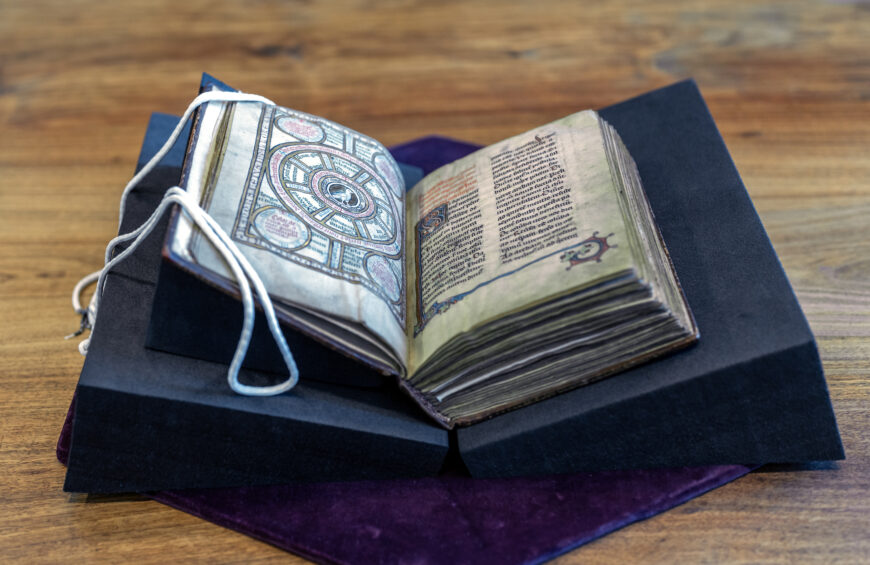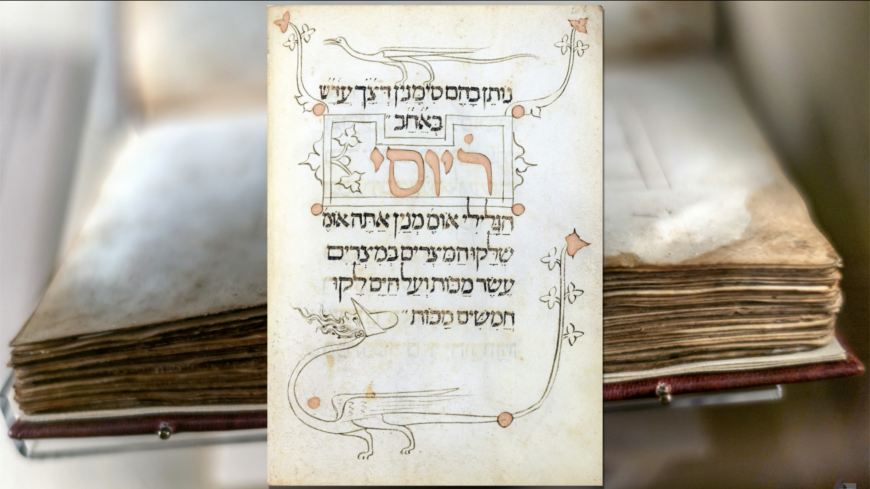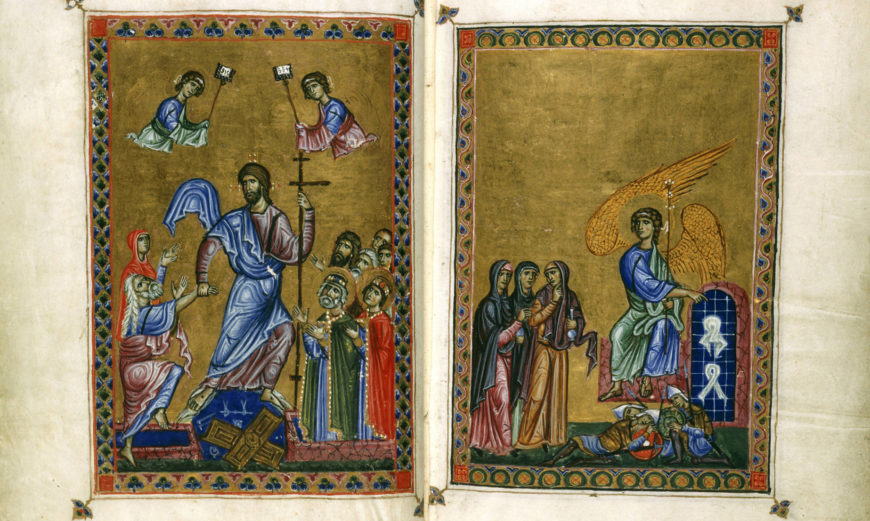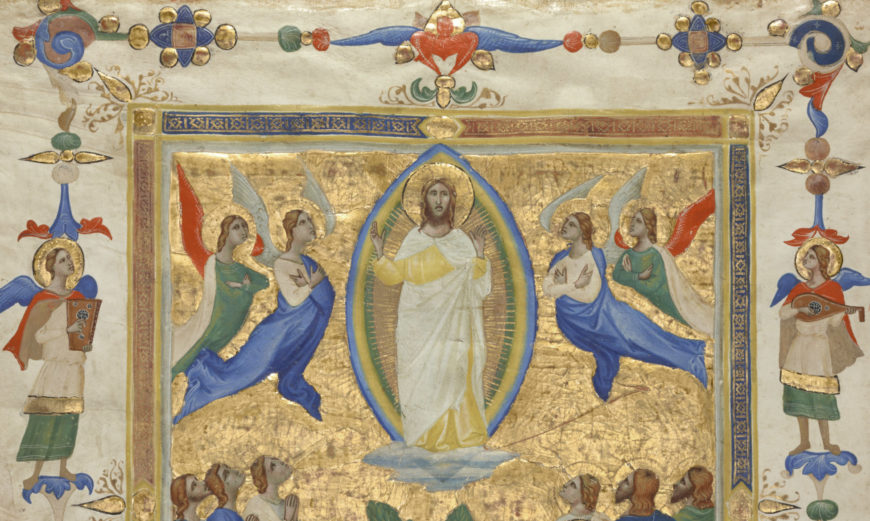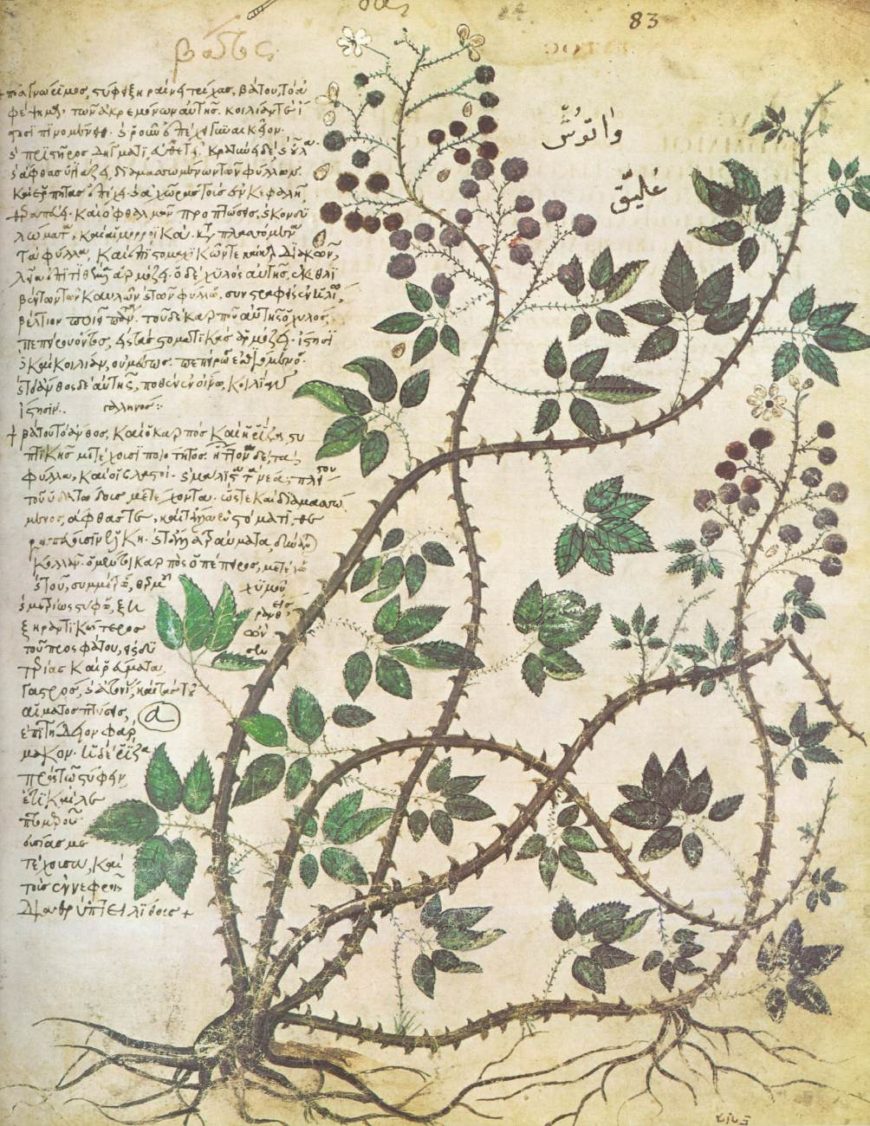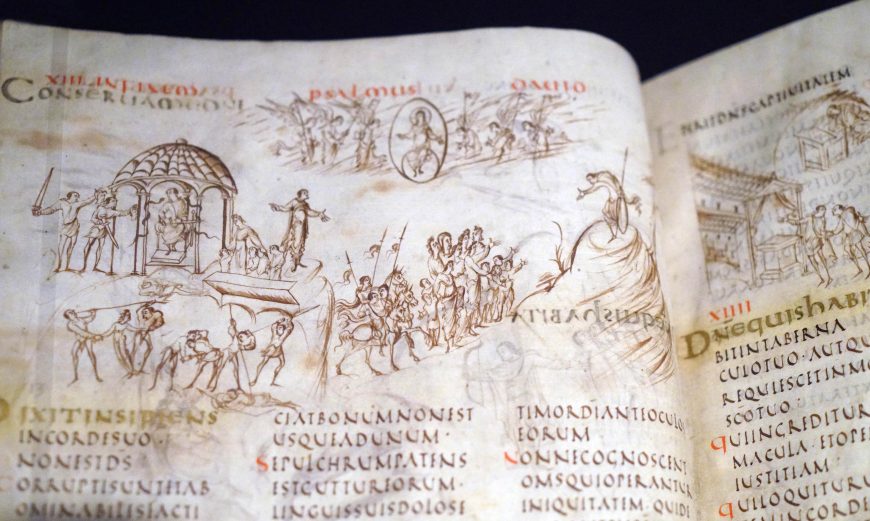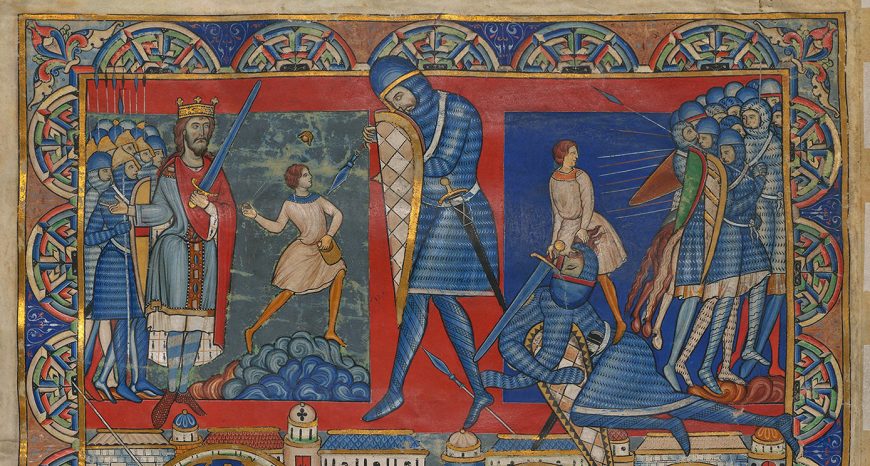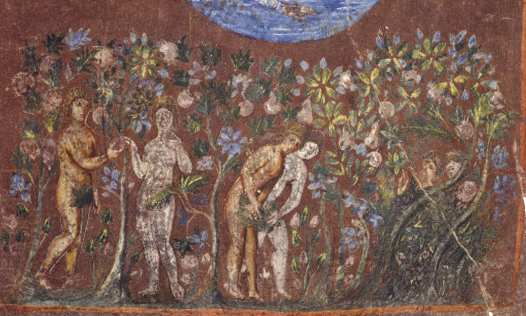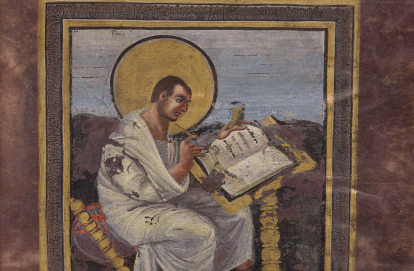This visually dazzling manuscript helped lift King Louis IX to sainthood. A dedication page shows the book’s illuminator at work.
Moralized Bible, c. 1227–34 (France, probably Paris), 37.5 x 26.2 cm, MS M.240, folios 7 verso and 8 recto (The Morgan Library & Museum, New York). Speakers: Dr. Joshua O’Driscoll, Associate Curator of Medieval & Renaissance Manuscripts, The Morgan Library & Museum, and Dr. Steven Zucker
0:00:05.2 Dr. Steven Zucker: We’re at the Morgan Library and Museum looking at one of the most celebrated manuscripts from the medieval era. This is a Moralized Bible, which is usually referred to as the Toledo Moralized Bible because most of it is in the Spanish city of Toledo. But the very last part of the book is here in New York.
0:00:27.4 Dr. Joshua O’Driscoll: A Moralized Bible is a new type of illuminated manuscript that first appears in the 13th century. There’s really nothing like it before. There are a set of these that are produced, and they’re all linked with the French Royal House. It is essentially a picture book of the Bible. This is the last quire of a three-volume Bible.
0:00:45.1 Dr. Steven Zucker: Now, by quire, we’re talking about a gathering of pages and the way that they nestle in with each other and then would ultimately be sewn together.
0:00:54.6 Dr. Joshua O’Driscoll: And one of the things that is so special about this book is that we know that the images came first. Normally in a medieval manuscript, a scribe would’ve begun by writing out the text on the parchment. Here, however, we know that the artist started first and created a vast amount of medallions depicting scenes from the entire Bible. In fact, the full set contained almost 5,000 medallions.
0:01:17.9 Dr. Steven Zucker: This is an unbelievable undertaking. Now this is all made on animal skin, so we’re talking about a herd of animals, but that’s only the very beginning because most of the labor, most of the artistry is in the text and especially in the imagery.
0:01:33.0 Dr. Joshua O’Driscoll: The core unit of a Moralized Bible comprises four parts: a biblical verse or excerpt, a roundel that illustrates that biblical excerpt, and then directly below, a commentary on that biblical verse, and then an image that illustrates that commentary. This is the last chapter of Apocalypse, the last book of the Bible. And you see John, the author, speaking with an angel, and the angel is telling John that we have to persist in the presence of evil. And right next to them, you see a couple embracing. This couple is depicting carnal sin. And to the right of that couple, you see a Dominican monk walking out of the scene ignoring that sin. In the commentary image, you see another scene of preaching in the face of evil. You see a Franciscan monk preaching to a group of people while a soldier looks on menacingly with a sword. At right you see a scene of martyrdom. A man is praying with his hands raised, indicating that he’s maintaining his faith even though he’s about to be executed.
0:02:29.8 Dr. Joshua O’Driscoll: And above them, you see the souls of the saved in heaven. And the artists were really trying to add visual interest to these scenes, even though there were thousands of them. And one of the great things they did is they made visual parallels between the pair of roundels. So you could see the figures on the left are in a dialogue with each other, and the figures on the right are looking outward. And in this way, the artist is drawing connections between the two scenes and encouraging the viewer to make these interpretations on their own.
0:02:57.6 Dr. Steven Zucker: And you can actually see in the very last image somebody who may be an artist, may be a scribe. But on the page, we can clearly see medallions that have not yet been painted.
0:03:10.3 Dr. Joshua O’Driscoll: Only two pages in the Bible don’t take this format. The first page, which is a great frontispiece, showing God as a creator, and then the very last page, which is the end of the manuscript and forms what could be thought of as a pictorial colophon. Now, a colophon is a scribal statement that says something about the circumstances of a manuscript’s creation. And this page doesn’t have any text on it, and yet it tells us something about how and why this manuscript was made. You see four figures arranged in a grid: a queen and a king, and then two below, an advisor and a craftsman. We can speculate that this Bible was commissioned by Blanche of Castile for her son, Louis IX.
0:03:49.4 Dr. Steven Zucker: Louis IX is one of the most renowned French monarchs. He’s known as Saint Louis. He was canonized, that is, he was made a saint soon after his death, and he’s quite famous for bringing the crown of thorns to Paris and building one of the most opulent treasure houses for that holy relic, Sainte-Chapelle.
0:04:08.9 Dr. Joshua O’Driscoll: And his mother is no less famous. Blanche was an incredible woman who was born in Spain as the daughter of the king, and she came to France at the age of 12. When she was in her 30s, her husband Louis VIII died and she served as Queen Regent of France while her son Louis IX was in minority. And this manuscript was created probably during her time as Regent. And we could speculate that perhaps she commissioned it as a gift to her young son upon his coronation. He was 12 years old at the time, or he may have received it as a gift when he assumed his majority when he turned 20.
0:04:44.1 Dr. Steven Zucker: So let’s take a close look at those figures as was intended. I think it’s pretty clear that we’re meant to begin with the Queen.
0:04:51.1 Dr. Joshua O’Driscoll: Well, she’s certainly the starting point. Just as you would start reading any page from the upper left corner, she is also shown in a gesture of active discussion. She’s clearly one of the moving forces in this image, and that fits well with what we believe the historical circumstances of this manuscript’s creation were. She was almost certainly the commissioner of this great project, and she’s shown here speaking to her son, and that’s probably telling us what she intended to do with this Bible—to provide her son with the knowledge that he needed to rule as king. And remember, this probably happened while she was serving as Queen Regent, and her son was just a teenager.
0:05:29.9 Dr. Steven Zucker: A teenager who was about to take over the governance of an entire nation. And so she was encouraging his training not only in biblical literature in its meaning, but especially in the moral power that it could convey. King Louis is shown not with a full beard, but just a little bit of hair on his chin. Yet he does hold symbols of rulership. He holds a scepter, and he holds a small gold round object.
0:05:54.7 Dr. Joshua O’Driscoll: The identity of what he’s holding has been debated by scholars. It could be a depiction of a royal orb, which is a traditional symbol of power over the world, or it could be his golden seal, which he would use as a king to make proclamations. Some scholars have even suggested that it could be a coin, but I tend to think that it probably is meant to be understood as the royal orb. And you see him here with other regalia: the crown, the scepter, and the orb, and of course, his magnificent throne. One of the key things in understanding the great final image is to understand how it depends on this structure of the Moralized Bible, just as there are four constituent elements to the Moralized Bible, the two text excerpts and the two roundels there are now four figures here, the queen, the king, the scholar, and the craftsman. And this structure, this grid, allows for an enormous amount of meaning to be generated. The viewer is invited to read both across, but also from top down and make connections between the figures.
0:06:53.8 Dr. Steven Zucker: All four figures are shown against this lavish field of gold that has been highly burnished.
0:07:00.1 Dr. Joshua O’Driscoll: The setting has a timeless quality to it with the gold ground and this magnificent architectural framework that signifies both an urban setting, such as Paris, but also the descriptions of heavenly Jerusalem that one finds in the Book of the Apocalypse itself.
0:07:13.9 Dr. Steven Zucker: So on the one hand, we see a relationship between Blanche and her son, Louis IX, but there’s also a visual relationship that exists vertically.
0:07:21.4 Dr. Joshua O’Driscoll: One of the wonderful things about this image is how it works across many different directions. So you have this very clear relationship between Blanche and her son, Blanche’s gesturing towards her son, educating him, speaking to him, and he is receiving her words of advice. If you look at the bottom register, you see the exact same thing happening between the cleric, the advisor, and the craftsman. The person on the bottom left is tonsured, and he was probably a religious figure or a cleric. He may have been one of the advisors working at the University of Paris that we believe were behind the intellectual components of the Moralized Bible. A team of theological advisors probably worked together to select the appropriate biblical passages and to compose the moralizations or the commentaries on those passages. They also probably decided which scenes should be illustrated and may even have indicated to the artists how to illustrate those scenes in particular.
0:08:13.9 Dr. Joshua O’Driscoll: And that’s what we see in the bottom register of this colophon. We see an advisor gesturing towards a craftsman, just as Blanche gestures towards her son. He’s probably explaining what he should be filling in the blank roundels that are on his page. Now, the identity of this craftsman has been debated by scholars. He could be a scribe writing in the text, or he could be an artist adding in the under drawings of the roundels, just as the scholar is telling the craftsman what to do, and he’s executing it, so too should Louis be enacting the very advice that Blanche is giving him.
0:08:45.5 Dr. Steven Zucker: And the parallel continues while Louis holds a scepter and perhaps an orb, the scribe or artist also holds two objects. In his left hand he holds a knife, in his right hand he holds a quill. The knife was a common tool for an artist and a scribe. So when you needed to correct something, you would use a knife to scrape away at the vellum to literally erase that error.
0:09:09.0 Dr. Joshua O’Driscoll: And the two together, the knife and the quill, are symbols of careful production. You have both sides of the equation, the action and the editing.
0:09:17.5 Dr. Steven Zucker: Looking carefully at these figures, they are so elegant, they’re slightly elongated, they’re quite thin, and there’s a very fine line that’s been used to describe them. The drapes fall in almost curly cues at the hem.
0:09:30.4 Dr. Joshua O’Driscoll: You can see she’s wearing an elegant floor-length red dress that’s lined in green. She has a large blue cloak that’s lined in ermine, and she has a white veil, which could be a symbol of her status as a widow. She’s also shown as particularly pale with strikingly blue eyes and red lips. These are probably not signs of her actual physical appearance, but rather idealized depictions of feminine beauty.
0:09:53.5 Dr. Steven Zucker: This pairing of two rulers sitting side by side is something that would’ve been recognized by people at this time.
0:10:02.3 Dr. Joshua O’Driscoll: The imagery closely relates to depictions of the Coronation of the Virgin, which similarly show the mother of God at left, crowned, gesturing towards Christ who’s shown enthroned on the right. You see images like this in churches around France.
0:10:14.9 Dr. Steven Zucker: It would’ve been perhaps too presumptuous to actually spell that out in text.
0:10:20.6 Dr. Joshua O’Driscoll: But the image does that unmistakably and unassailably. It would’ve been impossible not to make that connection for a contemporary viewer, and it is certainly one that was intended by the artist in this image. It’s a way of depicting the French royalty at the highest possible level. And ultimately, this image is a statement of authority of the Capetian right to rule.
0:10:38.1 Dr. Steven Zucker: And one of the aspects of the gold ground that I find most spectacular is that it’s been tooled, that it’s been stamped [to] create an even more opulent surface.
0:10:48.6 Dr. Joshua O’Driscoll: The artists of these manuscripts found ways to enliven the page and to break up the rigid symmetry. On this page the artist tooled the gold ground in two different ways. On the lower left, you could see a grid of diagonal lines providing the background for the scholar. And in the upper right, you see a much more florid winding tendrils behind the depiction of Louis. This no doubt suggests an idea of flourishing of life, of thriving, and this idea of alternating decorative motifs carries on throughout the Moralized Bible itself. If you look carefully at the arrangement of the medallions, you notice that on the left column there’s a blue background. The medallions themselves are red, and the trefoils between them are also red. That shifts to the opposite case in the right column. You have a red background with blue medallions and blue trefoils, and this alternating of red and blue colors, which is a key characteristic of Gothic illuminations, also happens in the depiction of the clothes between Blanche and Louis. She’s wearing a red dress with a blue cloak, and Louis is wearing a red cloak with a blue tunic. And that is another way that these figures are linked to the underlying structure of the Moralized Bible itself.
0:11:53.1 Dr. Steven Zucker: And it’s a reminder of the precision and planning that went into this book. This would have cost an unimaginable amount of effort and money and time. And so we should not be surprised that nothing here is left to chance.
0:12:08.0 Dr. Joshua O’Driscoll: There was no doubt that a great deal of planning and preparation went into the production of these manuscripts. Every little detail is planned out and thought through.
0:12:18.3 Dr. Steven Zucker: The entire book is intact with the exception of these very last pages.
0:12:23.8 Dr. Joshua O’Driscoll: The three volumes have been in Spain since the 13th century, and it’s probably the case that Louis IX gave this book as a gift to Alfonso X, the King of Spain. We know that this last choir of the Toledo Bible was removed by the early 15th century. Its binding dates to around 1500. And at that point it was in a private French collection, and it stayed in private French collections until the early 20th century when it was purchased by Pierpont Morgan for an astronomical sum. And we have accounts from the 15th century onward of visitors encountering the Moralized Bible and describing it as one of the most spectacular Bibles they’ve ever seen. Several people, in fact describe it as the most luxurious Bible ever produced.
0:13:00.0 Dr. Steven Zucker: And when I stand here in the Morgan Library, I can’t help but agree.
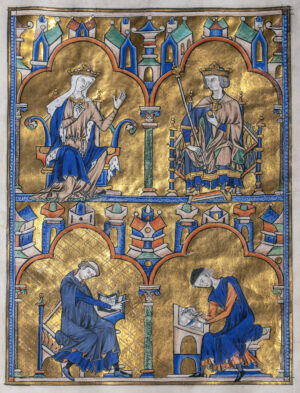
Top: Blanche of Castile and King Louis IX of France; and below: Author Dictating to a Scribe, Bible of Saint Louis (Moralized Bible), c. 1227–34 (France, probably Paris), 37.5 x 26.2 cm (The Morgan Library & Museum, New York, MS M.240, folio 8; photo: Steven Zucker, CC BY-NC-SA 2.0)
Blanche of Castile
In 1226 a French king died, leaving his queen to rule his kingdom until their son came of age. The 38-year-old widow, Blanche of Castile, had her work cut out for her. Rebelling barons were eager to win back lands that her husband’s father had seized from them. They rallied troops against her, defamed her character, and even accused her of adultery and murder.
Caught in a perilous web of treachery, insurrections, and open warfare, Blanche persuaded, cajoled, negotiated, and fought would-be enemies after her husband, King Louis VIII, died of dysentery after only a three-year reign. When their son Louis IX took the helm in 1234, he inherited a kingdom that was, for a time anyway, at peace.
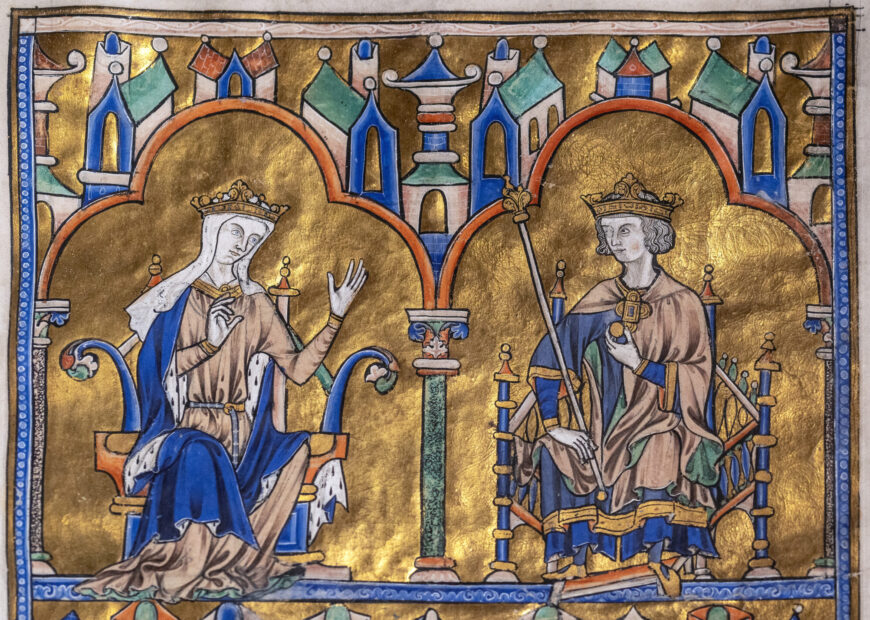
Blanche of Castile and King Louis IX of France (detail), Dedication Page with Blanche of Castile and King Louis IX of France, Bible of Saint Louis (Moralized Bible), c. 1227–34 (France, probably Paris), 37.5 x 26.2 cm (The Morgan Library & Museum, New York, MS M.240, folio 8; photo: Steven Zucker, CC BY-NC-SA 2.0)
A manuscript illumination
A dazzling illumination in New York’s Morgan Library could well depict Blanche of Castile and her son Louis, a beardless youth crowned king. A cleric and a scribe are depicted underneath them (see image at the top of the page). Each figure is set against a ground of burnished gold, seated beneath a trefoil arch. Stylized and colorful buildings dance above their heads, suggesting a sophisticated, urban setting—perhaps Paris, the capital city of the Capetian kingdom (the Capetians were one of the oldest royal families in France) and home to a renowned school of theology.
A moralized Bible
This last page the New York Morgan Library’s manuscript MS M 240 is the last quire (folded page) of a three-volume moralized bible, the majority of which is housed at the Cathedral Treasury in Toledo, Spain. Moralized bibles, made expressely for the French royal house, include lavishly illustrated abbreviated passages from the Old and New Testaments. Explanatory texts that allude to historical events and tales accompany these literary and visual readings, which—woven together—convey a moral.
Assuming historians are correct in identifying the two rulers, we are looking at the four people intensely involved in the production of this manuscript. As patron and ruler, Queen Blanche of Castile would have financed its production. As ruler-to-be, Louis IX’s job was to take its lessons to heart along with those from the other biblical and ancient texts that his tutors read with him.
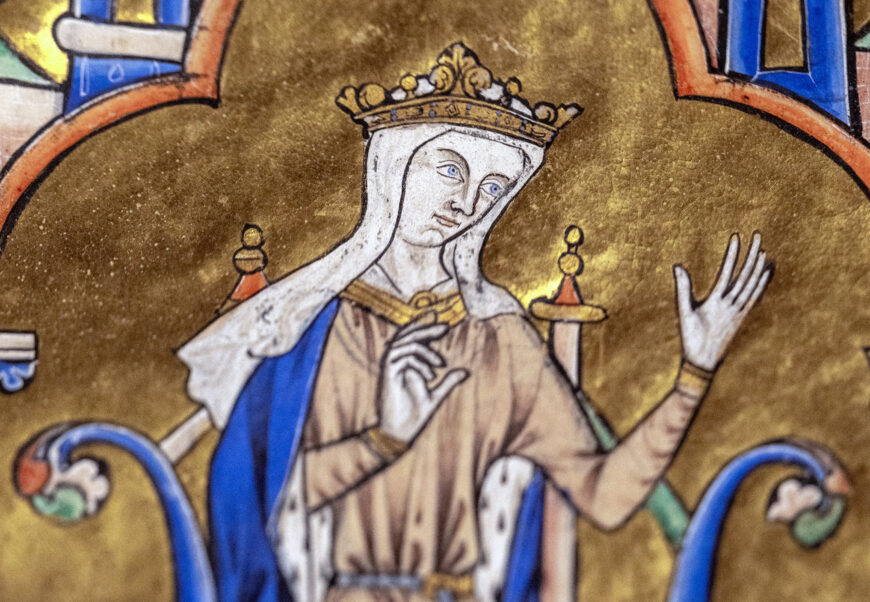
Blanche of Castile (detail), Dedication Page with Blanche of Castile and King Louis IX of France, Bible of Saint Louis (Moralized Bible), c. 1227–34 (France, probably Paris), 37.5 x 26.2 cm (The Morgan Library & Museum, New York, MS M.240, folio 8; photo: Steven Zucker, CC BY-NC-SA 2.0)
King and queen

Louis IX (detail), Dedication Page with Blanche of Castile and King Louis IX of France, Bible of Saint Louis (Moralized Bible), c. 1227–34 (France, probably Paris), 37.5 x 26.2 cm (The Morgan Library & Museum, New York, MS M.240, folio 8; photo: Steven Zucker, CC BY-NC-SA 2.0)
In the upper register, an enthroned king and queen wear the traditional medieval open crown topped with fleur-de-lys—a stylized iris or lily symbolizing a French monarch’s religious, political, and dynastic right to rule. The blue-eyed queen, left, is veiled in a white widow’s wimple. An ermine-lined blue mantle drapes over her shoulders. Her pink T-shaped tunic spills over a thin blue edge of paint which visually supports these enthroned figures. A slender green column divides the queen’s space from that of her son, King Louis IX, to whom she deliberately gestures across the page, raising her left hand in his direction. Her pose and animated facial expression suggest that she is dedicating this manuscript, with its lessons and morals, to the young king.
Louis IX, wearing an open crown atop his head, returns his mother’s glance. In his right hand he holds a scepter, indicating his kingly status. It is topped by the characteristic fleur-de-lys on which, curiously, a small bird sits. A four-pedaled brooch, dominated by a large square of sapphire blue in the center, secures a pink mantle lined with green that rests on his boyish shoulders.
In his left hand, between his forefinger and thumb, Louis holds a small golden ball or disc. During the mass that followed coronations, French kings and queens would traditionally give the presiding bishop of Reims 13 gold coins (all French kings were crowned in this northern French cathedral town.) This could reference Louis’ 1226 coronation, just three weeks after his father’s death, suggesting a probable date for this bible’s commission. A manuscript this lavish, however, would have taken eight to ten years to complete—perfect timing, because in 1235, the 21-year-old Louis was ready to assume the rule of his Capetian kingdom from his mother.
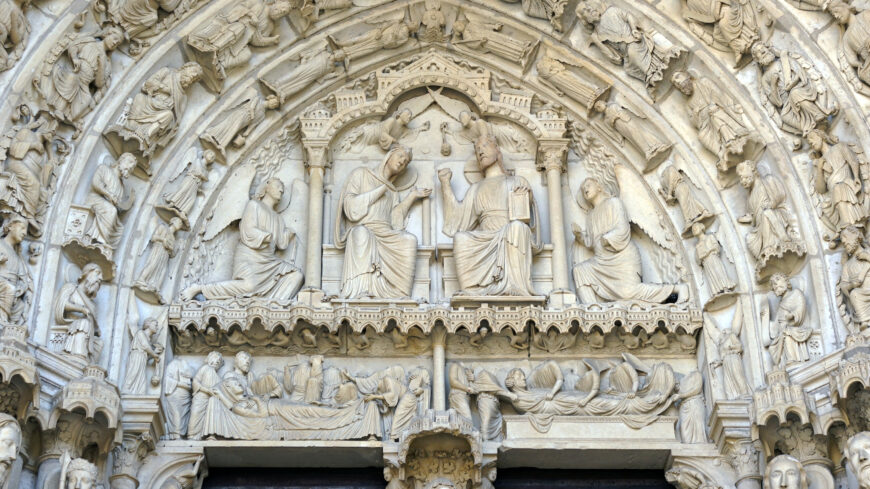
Coronation of the Virgin, tympanum of central portal, north transept, Chartres Cathedral, c. 1204–10 (photo: Steven Zucker, CC BY-NC-SA 2.0)
A link between earth and heaven
Queen Blanche and her son, the young king, echo a gesture and pose that would have been familiar to many Christians: the Virgin Mary and Christ enthroned side-by-side as celestial rulers of heaven, found in the numerous Coronations of the Virgin carved in ivory, wood, and stone. This scene was especially prevalent in tympana, the top sculpted semi-circle over cathedral portals found throughout France. On beholding the Morgan illumination, viewers would have immediately made the connection between this earthly Queen Blanche and her son, anointed by God with the divine right to rule, and that of Mary, Queen of heaven and her son, divine figures who offer salvation.
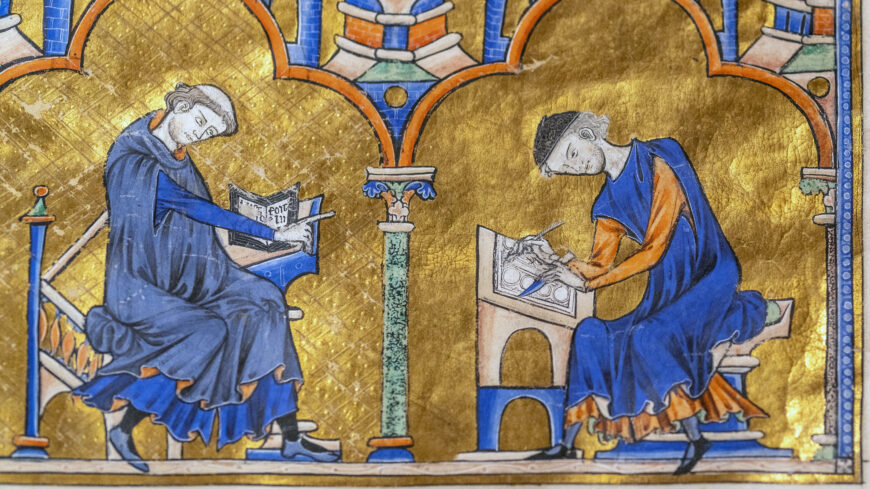
Cleric (left) and scribe (right) (detail), Dedication Page with Blanche of Castile and King Louis IX of France, Bible of Saint Louis (Moralized Bible), c. 1227–34 (France, probably Paris), 37.5 x 26.2 cm (The Morgan Library & Museum, New York, MS M.240, folio 8; photo: Steven Zucker, CC BY-NC-SA 2.0)
A cleric and an artist
The illumination’s bottom register depicts a tonsured cleric (churchman with a partly shaved head), left, and an illuminator, right.
The cleric wears a sleeveless cloak appropriate for divine services—this is an educated man—and emphasizes his role as a scholar. He tilts his head forward and points his right forefinger at the artist across from him, as though giving instructions. No clues are given as to this cleric’s religious order, as he probably represents the many Parisian theologians responsible for the manuscript’s visual and literary content—all of whom were undoubtedly told to spare no expense.
On the right, the artist, donning a blue surcoat and wearing a cap, is seated on cushioned bench.
Knife in his left hand and stylus in his right, he looks down at his work: four vertically-stacked circles in a left column, with part of a fifth visible on the right. We know, from the 4887 medallions that precede this illumination, what’s next on this artist’s agenda: he will apply a thin sheet of gold leaf onto the background, and then paint the medallion’s biblical and explanatory scenes in brilliant hues of lapis lazuli, green, red, yellow, grey, orange, and sepia.
Advice for a king
Blanche undoubtedly hand-picked the theologians whose job it was to establish this manuscript’s guidelines, select biblical passages, write explanations, hire copyists, and oversee the images that the artists should paint. Art and text, mutually dependent, spelled out advice that its readers, Louis IX and perhaps his siblings, could practice in their enlightened rule. The nobles, church officials, and perhaps even common folk who viewed this page could be reassured that their ruler had been well trained to deal with whatever calamities came his way.
This 13th-century illumination, both dazzling and edifying, represents the cutting edge of lavishness in a society that embraced conspicuous consumption. As a pedagogical tool, perhaps it played no small part in helping Louis IX achieve the status of sainthood, awarded by Pope Boniface VIII 27 years after the king’s death. This and other images in the bible moralisée explain why Parisian illuminators monopolized manuscript production at this time. Look again at the work. Who else could compete against such a resounding image of character and grace?


